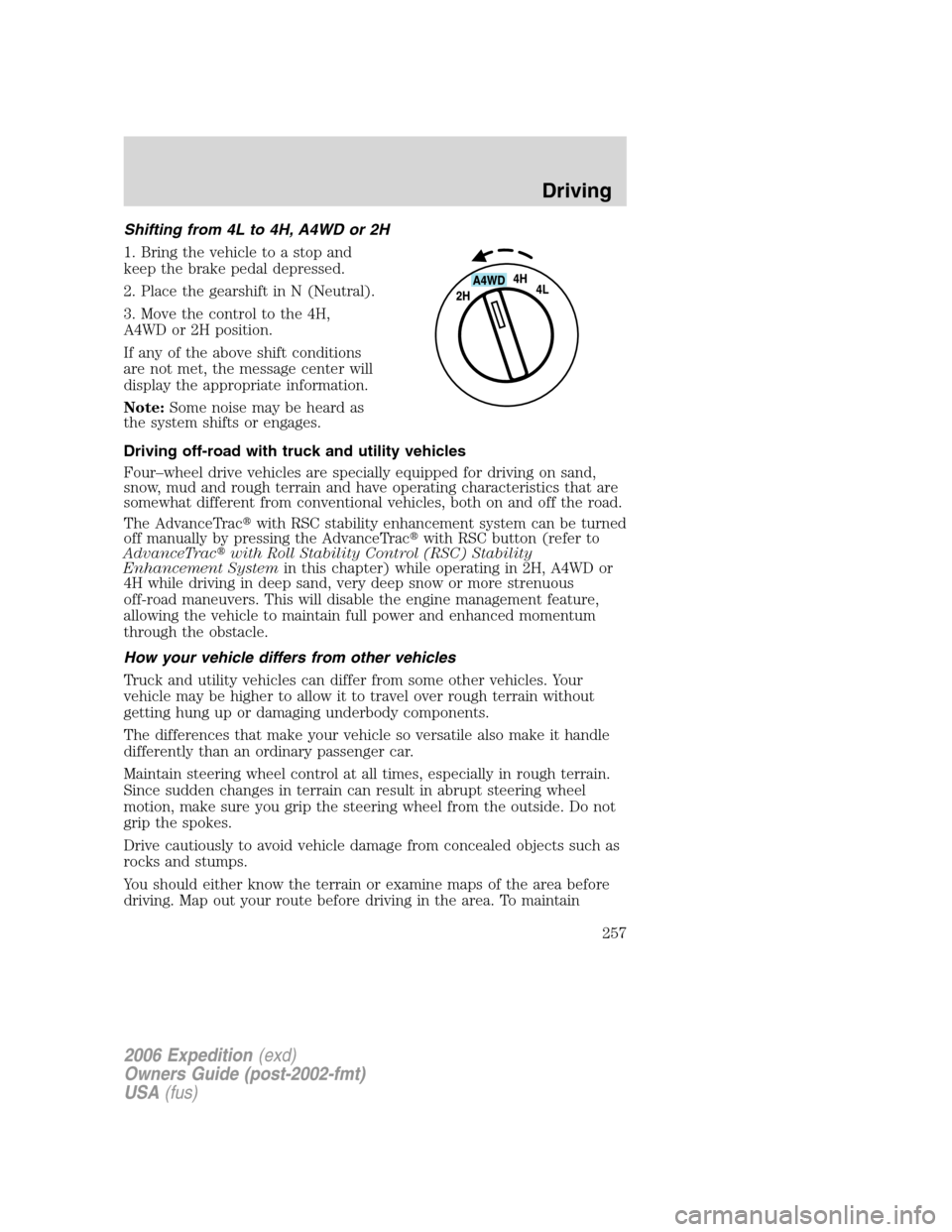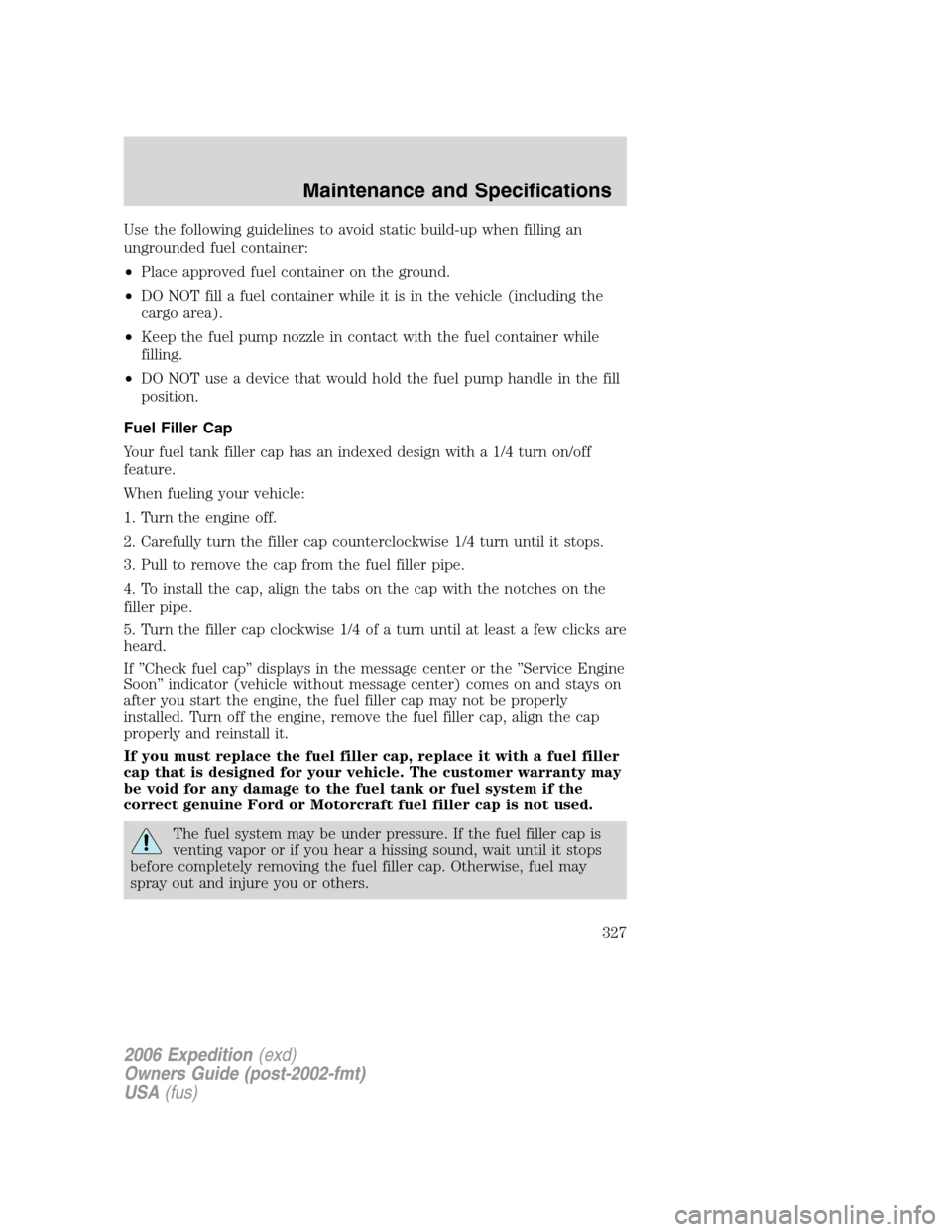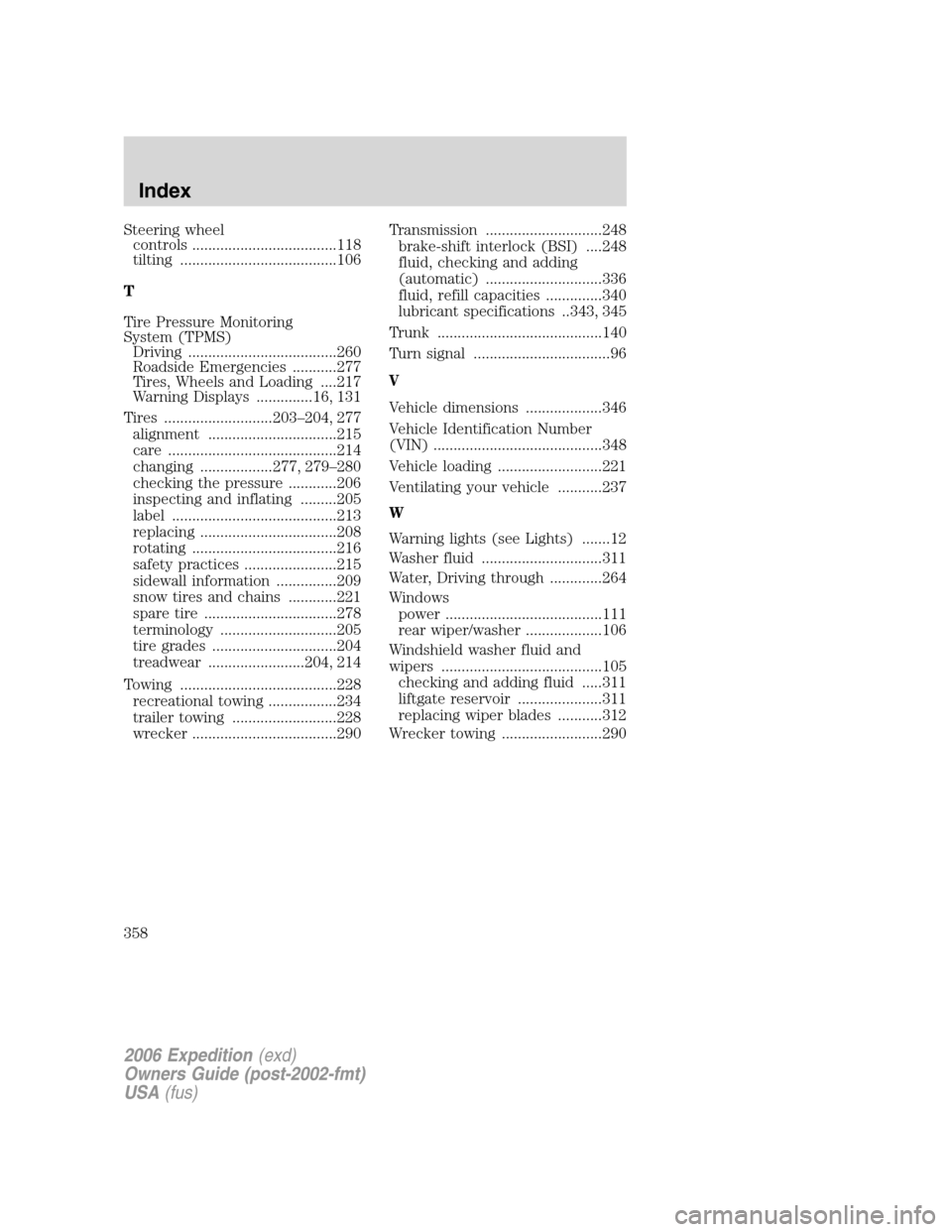Page 257 of 360

Shifting from 4L to 4H, A4WD or 2H
1. Bring the vehicle to a stop and
keep the brake pedal depressed.
2. Place the gearshift in N (Neutral).
3. Move the control to the 4H,
A4WD or 2H position.
If any of the above shift conditions
are not met, the message center will
display the appropriate information.
Note:Some noise may be heard as
the system shifts or engages.
Driving off-road with truck and utility vehicles
Four–wheel drive vehicles are specially equipped for driving on sand,
snow, mud and rough terrain and have operating characteristics that are
somewhat different from conventional vehicles, both on and off the road.
The AdvanceTrac�with RSC stability enhancement system can be turned
off manually by pressing the AdvanceTrac�with RSC button (refer to
AdvanceTrac�with Roll Stability Control (RSC) Stability
Enhancement Systemin this chapter) while operating in 2H, A4WD or
4H while driving in deep sand, very deep snow or more strenuous
off-road maneuvers. This will disable the engine management feature,
allowing the vehicle to maintain full power and enhanced momentum
through the obstacle.
How your vehicle differs from other vehicles
Truck and utility vehicles can differ from some other vehicles. Your
vehicle may be higher to allow it to travel over rough terrain without
getting hung up or damaging underbody components.
The differences that make your vehicle so versatile also make it handle
differently than an ordinary passenger car.
Maintain steering wheel control at all times, especially in rough terrain.
Since sudden changes in terrain can result in abrupt steering wheel
motion, make sure you grip the steering wheel from the outside. Do not
grip the spokes.
Drive cautiously to avoid vehicle damage from concealed objects such as
rocks and stumps.
You should either know the terrain or examine maps of the area before
driving. Map out your route before driving in the area. To maintain
2006 Expedition(exd)
Owners Guide (post-2002-fmt)
USA(fus)
Driving
257
Page 327 of 360

Use the following guidelines to avoid static build-up when filling an
ungrounded fuel container:
•Place approved fuel container on the ground.
•DO NOT fill a fuel container while it is in the vehicle (including the
cargo area).
•Keep the fuel pump nozzle in contact with the fuel container while
filling.
•DO NOT use a device that would hold the fuel pump handle in the fill
position.
Fuel Filler Cap
Your fuel tank filler cap has an indexed design with a 1/4 turn on/off
feature.
When fueling your vehicle:
1. Turn the engine off.
2. Carefully turn the filler cap counterclockwise 1/4 turn until it stops.
3. Pull to remove the cap from the fuel filler pipe.
4. To install the cap, align the tabs on the cap with the notches on the
filler pipe.
5. Turn the filler cap clockwise 1/4 of a turn until at least a few clicks are
heard.
If ”Check fuel cap” displays in the message center or the ”Service Engine
Soon” indicator (vehicle without message center) comes on and stays on
after you start the engine, the fuel filler cap may not be properly
installed. Turn off the engine, remove the fuel filler cap, align the cap
properly and reinstall it.
If you must replace the fuel filler cap, replace it with a fuel filler
cap that is designed for your vehicle. The customer warranty may
be void for any damage to the fuel tank or fuel system if the
correct genuine Ford or Motorcraft fuel filler cap is not used.
The fuel system may be under pressure. If the fuel filler cap is
venting vapor or if you hear a hissing sound, wait until it stops
before completely removing the fuel filler cap. Otherwise, fuel may
spray out and injure you or others.
2006 Expedition(exd)
Owners Guide (post-2002-fmt)
USA(fus)
Maintenance and Specifications
327
Page 358 of 360

Steering wheel
controls ....................................118
tilting .......................................106
T
Tire Pressure Monitoring
System (TPMS)
Driving .....................................260
Roadside Emergencies ...........277
Tires, Wheels and Loading ....217
Warning Displays ..............16, 131
Tires ...........................203–204, 277
alignment ................................215
care ..........................................214
changing ..................277, 279–280
checking the pressure ............206
inspecting and inflating .........205
label .........................................213
replacing ..................................208
rotating ....................................216
safety practices .......................215
sidewall information ...............209
snow tires and chains ............221
spare tire .................................278
terminology .............................205
tire grades ...............................204
treadwear ........................204, 214
Towing .......................................228
recreational towing .................234
trailer towing ..........................228
wrecker ....................................290Transmission .............................248
brake-shift interlock (BSI) ....248
fluid, checking and adding
(automatic) .............................336
fluid, refill capacities ..............340
lubricant specifications ..343, 345
Trunk .........................................140
Turn signal ..................................96
V
Vehicle dimensions ...................346
Vehicle Identification Number
(VIN) ..........................................348
Vehicle loading ..........................221
Ventilating your vehicle ...........237
W
Warning lights (see Lights) .......12
Washer fluid ..............................311
Water, Driving through .............264
Windows
power .......................................111
rear wiper/washer ...................106
Windshield washer fluid and
wipers ........................................105
checking and adding fluid .....311
liftgate reservoir .....................311
replacing wiper blades ...........312
Wrecker towing .........................290
2006 Expedition(exd)
Owners Guide (post-2002-fmt)
USA(fus)
Index
358